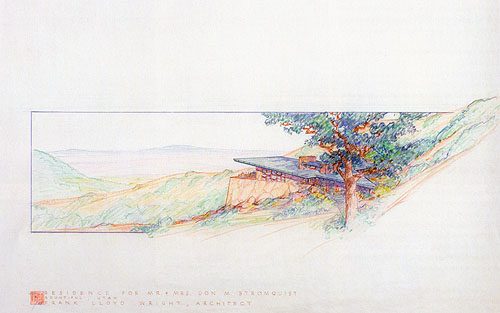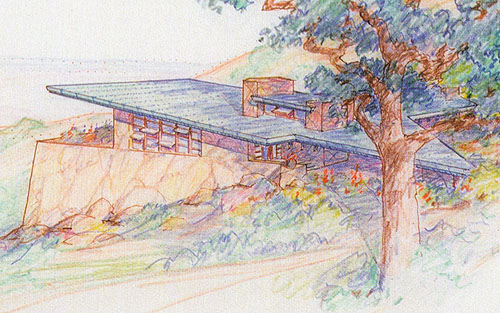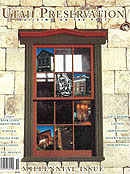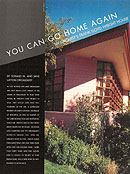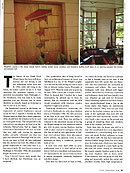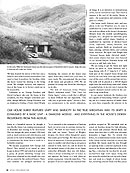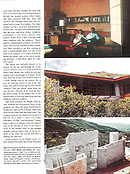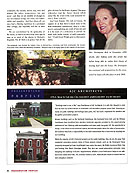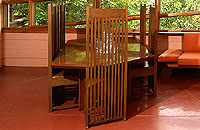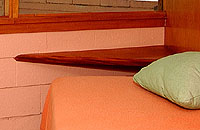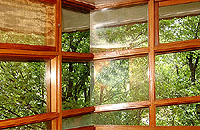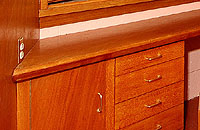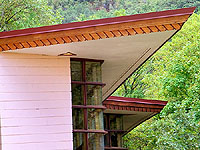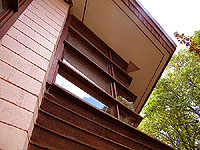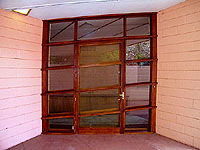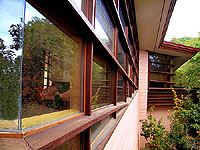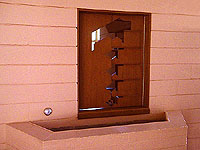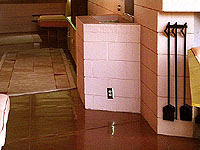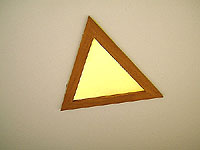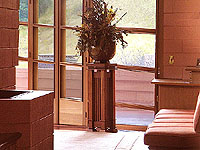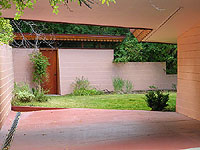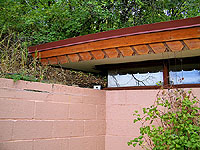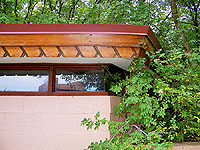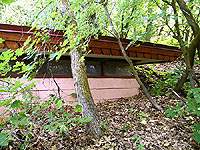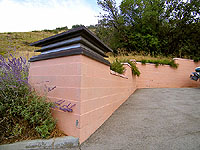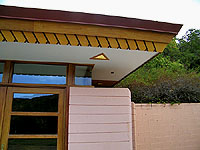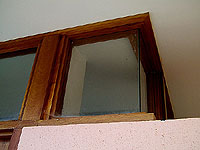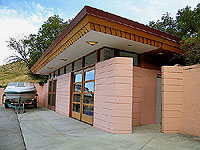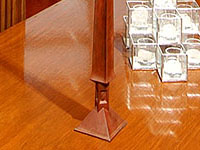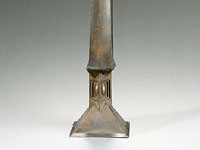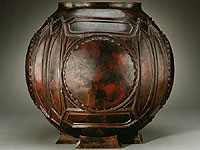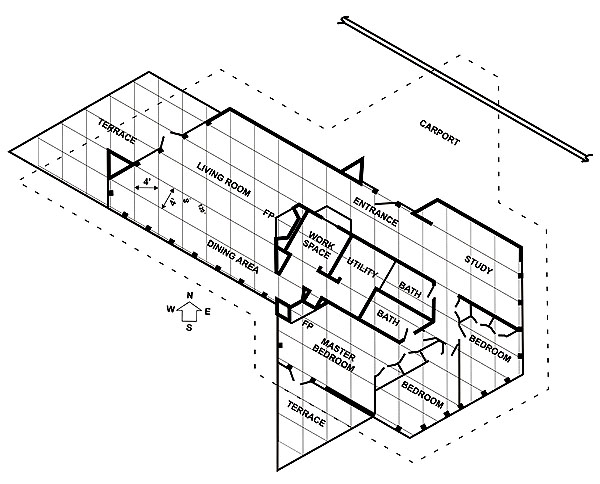Donald Martin Stromquist
(8/4/1924 - 8/27/2009) was born in Rockford, Illinois on
August 4, 1924. His parents were Swedish immigrants. His
first contact with Wright was as a boy in Illinois when he
had an opportunity to hear Mr. Wright speak. Mr. Wright’s
impact on Donald as a boy, is unmistakable. He graduated
from Marquette University with a degree in Chemical
Engineering. After serving in World War II, he worked for
the Illinois Water Treatment Company, where he created
several water purification patents. In 1947 he engineered
and coordinated the installation of a water treatment system
at the Layton Sugar Factory in Layton, just north of
Bountiful, Utah. He continued working with this client in
1948 and 1949, and the following year wrote and
published
an article about the process. In 1951 he co-authored another
article about his work with the Illinois Water Treatment
Company, Rockford, Illinois. It was
presented at the 25th Annual Meeting of the
American Oil Chemists, and
published in 1952. It was during
his time in Layton, Utah, that he met Jane Layton, a
descendant of the original settlers. Donald and Jane were
married in Layton, on January 31, 1953.
The Stromquists purchased a remote seven
acre parcel of land in a canyon high above the Great Salt
Lake. So remote it lacked power and water, but perfect for
someone with Donald’s engineering skills. They contacted
Wright about designing a home and in August 1957 met with
him at Taliesin in Spring Green to review the initial
drawings. Upon greeting them Wright exclaimed "Why you’re
just a couple of kids" (Utah). They loved the concept but
were concerned about cost. Wright made changes and sent new
plans on March 20, 1959 (Wright53-59 p 545). In 1960, a year
following Wright’s death, Taliesin Architects finished the
working drawings, following Wright’s second plan, but adding
a study.
Construction finally began in 1961 (WW
p101). Stromquist’s talents and abilities allowed him to
complete the furnishings and built-ins. Cornelia Brierly
worked with Mrs. Stromquiest "selecting appealing fabrics
for the home" (Tales p 104). "Crystalwood" was
completed in 1963 (Storrer p 461).
In November 1966, after just a few years in
their Wright home, the Stromquists were transferred to
Pittsburgh. Jane sat down on the floor in their Pittsburgh
duplex and cried (Utah). As agreed, their employer purchased
their home. It was put on the market, but due to the
remoteness, there were no buyers. It was unoccupied and
neglects. Transients burned the Wright designed furniture
Donald had painstakingly built. Then the doors and
built-ins.
It took two years for Donald to arrange
work as a rep and consultant and in 1968 moved back to Utah.
They visited their old home and were devastated. In their
estimate their Wright home was beyond repair. Tears welled
up in their eyes (Utah).
A buyer was found, but lacked any
appreciation for Wright’s design, let alone any Wright
details. The home was abused and continued to deteriorate.
"It fell into the unworthy hands of a man who kept horses in
the living room" (Tales p 104).
They threw themselves into another project,
the four-story William Culmer Victorian mansion in Salt Lake
City. For the next 18 years they painstakingly restored the
mansion. They discovered elaborate murals, by Salt Lake City
painter Henry Culmer, hidden under layers of wallpaper. It
took Dale Jolley 14 years to fully restore them. On April
30, 2000, Bob Vila highlighted their work on his weekly
television program..
Meanwhile, rescue was on the horizon for
the original Stromquist Home. In 1989 after more than twenty
years of neglect and abuse, the home was purchased with the
intent on restoration. George Frandsen and David Carlquist
contacted Taliesin. Restoration was to Wright’s original
specifications. Cornelia Brierly |
|
was approached and asked to work
on the home again, and with the help of John deKoven Hill,
new fabrics and carpets were selected and original furniture
was rebuilt (Tales p 104).
The Stromquists had the opportunity to meet
the new owners and in 1995 were invited to speak at their
open house. They were also told that if they ever were to
sell the home, the Stromquists would be at he top of their
list.
The Stromquist home is the only structure
designed by Wright in the state of Utah. As you approach the
home from the street below, the roof cantilevers skyward
over the living room and terrace. The living room has two
large walls of windows, one floor to ceiling. From the peak
over the living room, the roof slants down toward the back
of the home. Wright designed these windows to match the
slope of the roof. The slope of the windows is not
immediately evident, but becomes apparent as your eye
follows the slope at the floor. Wright used this window
design in only one other home. The
Archie Teater Studio.
The doors are a work of art. They are set within a wall of
glass. The top has the same slope as the roof. At first
glance, the bottom gives the appearance to be at a slant
also, but in reality is straight. The 2,700 square foot home
has three bedrooms, two bathrooms, a work space (kitchen),
living room, dining area, study, two fireplaces, one large
centrally located in the living room, and two terraces. It
is designed on a diamond grid consisting of 60 and 120 degree angles.
The basic materials are glass, concrete block and mahogany.
There are many classic Wright details. Originally designed
in stone, the Stromquists felt it would be to costly
(Masterworks p268). Wright replaced stone with concrete
block and raked only the horizontal joints, leaving the
vertical joints flush with the face of the brick. Wright
also changed the layout of the floor plan, and sent new
plans on March 20, 1959
(Wright p 544). In 1960, a
year following Wright’s death, Taliesin Architects finished
the working drawings, following Wright’s second plan, but
adding a study. The seating, lighting, desks, cabinets and
shelves are built-in. The kitchen has a perforated
decorative shutter that opens toward the entry. There are
mitered glass corner windows. Clerestory windows provide
natural lighting to the bathrooms. The master bedroom has a
fireplace and French doors that lead to a secluded terrace
(balcony). The seven acre parcel of land was expanded to ten
acres, and is in a canyon at 6,000 feet, high above the
Great Salt Lake. There is a separate
garage/office/laboratory, a shed and barn.
After ten years of ownership, including
five years refurbishing the home, George and David contacted
the Stromquists about purchasing the home. In 1998, the sale
was completed. Plans were made for moving back in, their
mansion was put on the market. The original dining room
table and some of the original hassocks, built by Donald
over forty years earlier, were "pressed into service" again.
The master bedroom fireplace that never functioned, was
repaired. (Utah).
Sadly Jane never realized her dream of
moving back into her dream house. She passed away in
November 1999. Donald was 75. He continued with their plans
and was able to move in 2000 and live in his Wright house
again for a few more years. His health finally required him
to move out. Donald passed away on August 27, 2009, just
after his 85th birthday.
"Whenever I see a Wright home or a
Wright photo or a Wright building, it always comes to me
with great intensity that Wright has mirrored Plato’s ideal
world. I can’t think of anything that I think would be
closer. It has to do with thought, a whole idealistic way of
life. It has to do with all the things that are the best in
us." Jane Stromquist. (Homearama)
Text by
Douglas M. Steiner, Copyright September 2009. |
